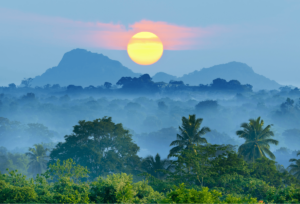The tropical sea life of the Dominican Republic is protected by a large Sanctuary for Marine Mammals that covers most of the country’s shores. This means that you can see whales, dolphins, manatees, turtles, coral reefs and numerous fish in a responsible and controlled way. In some areas, visitor numbers are limited – but this just means that there are less crowds and more protection for the sea creatures, many of which are endangered.
Whales and dolphins
The World Wildlife Fund considers the Bay of Samana as one of the best places in the world for whale watching. This is because in mating season, between January and March, up to 3,000 humpback whales come to the bay. They’re commonly active on the surface, so you get a really good look at them, particularly when they roll and slap their fin or tail on the water.
There are around 40 registered boats that’ll take you out in the water to see the whales up close for between two to four hours. Many longer tours also combine the chance to swim around Cayo Levantado Island or splash in El Limon waterfall, which crashes 170 feet from a mountain river above.
You don’t even need to get in the water to see these giant mammals though, as if you head to Cabo Frances Viejo or Cabo Samana in February you’ll be able to spot whales from the shore! Pilot whales and spotted dolphins can also be seen in Samana Bay.
Or take a trip out to Silver Bank, off the shores of Playa Dorada for the chance to spot bottlenose dolphins, as well as their acrobatic spinner dolphin cousins. Endangered West Indian manatees also swim in these shores, so you might be lucky and spot some of these ‘sea cows’ too.
Turtles
Four main species of marine turtles call the Dominican Republic home – leatherback, loggerhead, hawksbill and green turtles. All except the loggerhead turtles come to shore to lay their eggs on the beaches here in summer. Generally, leatherback turtles prefer the north of the island and green turtles the south, but both species lay eggs at Jaragua National Park and Saona Island, off the coast of La Romana.
While turtle nesting grounds are protected and the females lay their eggs at night, there are more turtles in the water during nesting season. This means you’re more likely to see them when heading out on a boat tour.
Coral and fish
You might not realise, but coral reefs are in fact a group of marine animal related to jellyfish and anemones. There are four sites along the Dominican Republic’s southern shores where you can swim around these fascinating eco-systems. Creatures that live around the reef and help it to thrive include parrotfish, sea urchins and sponges.
Taking a diving trip to see the reefs, you’ll also encounter some of the country’s fish population – such as large barracudas, manta rays, moray eels and Atlantic sailfish. You might also glimpse the fascinating porcupine fish – which puffs up its spikes when threatened – the long trumpet fish or the fancy lionfish.
Wherever you base yourself in the Dominican Republic, you’ll be close to spectacular sites for spotting magnificent sea life. Where will you choose to stay, and what creatures would you like to see? Let us know in the comments below.






